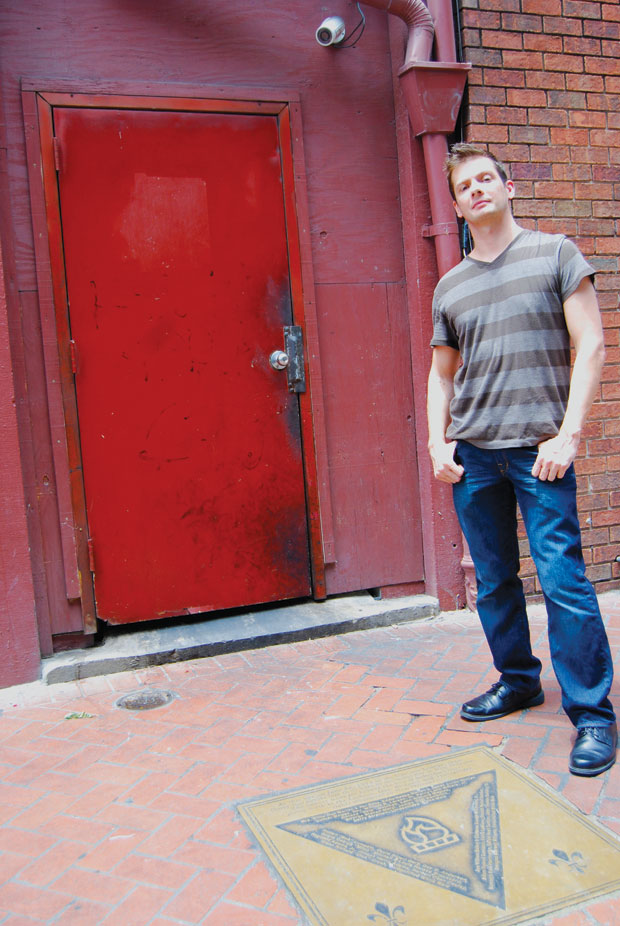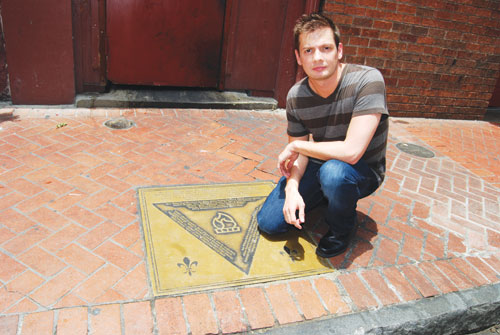Robert Camina revisits a gay bar to uncover the biggest anti-gay crime in U.S. history

A DOOR TO OUR HISTORY | Robert L. Camina stands outside the building that once housed the Upstairs Lounge in New Orleans, the site of the largest mass murder of gays in U.S. history.
ARNOLD WAYNE JONES | Life+Style Editor
Dallas filmmaker Robert L. Camina has become, without really trying, the unofficial documentarian of 40th anniversary events in gay history.
His 2012 film, Raid on the Rainbow Lounge, began on the 40th anniversary of the Stonewall Riots, when law enforcement officers stormed into a Fort Worth gay bar and started an avalanche of controversy. Officials claimed they had no idea of the significance of the date to the gay community and its parallels in sparking the gay rights movement. But history followed the story.
And now, Camina gets to follow history again.
Earlier this week, Camina announced his latest project on the 40th anniversary of another milestone in gay culture, albeit one less familiar to most people than Stonewall.

SCENE OF THE CRIME | Camina kneels beside the plaque memorializing the fire that killed 32 gay people in 1973.
On June 24, 1973, in New Orleans, a gay bar known as the Upstairs Lounge was firebombed, and 32 individuals were killed — most presumably gay men. It qualifies it as the largest mass murder of gays ever in the United States.
And Camina bets that you’ve never even heard of it.
“I think it’s important we honor our history,” Camina says. “We know about Stonewall, Harvey Milk, Matthew Shepard. But there is so much more to us.”
A killing of this magnitude, should have, even 40 years ago, triggered a national reaction. So why the obscurity?
“It was ‘just the gays — what does it matter?’” Camina opines. “There was blatant homophobia that existed in the media, in the police and fire departments, within the church not allowing services for the victims — the bodies were thrown into a pauper’s grave. News reporters [at the time] made jokes about it on the radio. It was just the queers — it didn’t hold a headline.”
Some of that anonymity was even orchestrated by the gay community of NOLA, who didn’t want it in the headlines. Some still don’t.
But Camina felt it was a story he had to tell.
“Sometimes you find a project, and sometimes the project finds you,” he says. “That’s how this came to be.”
At the beginning of the year, someone familiar with Raid on the Rainbow Lounge approached Camina, feeling his skills at storytelling and interest in gay rights made him “the perfect person to tell this story.” He was quickly hooked. “This story really struck a nerve on so many levels. I feel we can raise the consciousness of the people with this,” he says.
The Upstairs Lounge was known as a gaudy and fun gay bar in 1973, notable for its elaborate curtains and pop culture posters decorating the walls, as well as being air conditioned in the sweltering Crescent City. On the afternoon of June 24, following a beer bash as patrons commemorated the still-new gay Pride month, someone threw an incendiary device into the space. A back door was opened, causing a backdraft, which quickly spread the flames. The famed curtains ended up fueling the blaze. Complicating matters: There was only one entrance stairway and one exit. Once the stairs were lit, “it became a tinderbox,” Camina says.
Thirty-two people eventually died, some from immolation, some from smoke inhalation, some from injuries sustained when they jumped from an upper-story window to escape the fire. Even today, three of the fatalities were never identified — probably because their families never wanted to come forward and acknowledge their gay relative.
Recounting these stories has plainly affected Camina. His voice cracks and his eyes well up as he explains the anniversary service, held just this week.
“It was really emotional — probably more than I was prepared for,” he says. “The magnitude of the tragedy really hit me when I went outside the Upstairs Lounge and imagined the mood 40 years ago: The smell of the soot, the sadness, the heaviness. It kind of overwhelmed me, the anxiety of it all, putting myself in their shoes.”
Camina recalls two especially poignant deaths. In one instance, a bartender heroically led several of the patrons through a back service route. After he had successfully emerged, one of those who escaped, an assistant pastor at the MCC, realized his boyfriend was not among the survivors. He rushed back into the burning building. “They died together, their bodies found next to each other,” Camina says.
Another image is also emblazoned on Camina’s memory. The pastor of the local Metropolitan Community Church tried to escape through a window, but became trapped between the burglar bars that had been recently installed. “He got wedged in the bars and was burned alive, crying out, ‘God no!’”
No one was ever prosecuted for the crime; the police had a suspect, who committed suicide before he could be fully investigated and charged. As a result, many familiar with the circumstances have never felt a sense of closure. Camina hopes this film, which he has titled Upstairs Inferno, might provide that.
He’s on the mission now. Until August, Upstairs Inferno is the subject of an online crowd-funding campaign through IndieGoGo.com (he’s already more than a third of the way to his goal).
But it’s also not lost on Camina the significance of this week in gay history: Not only is this the 40th anniversary of the bombing, but the 44th of Stonewall, the fourth of Rainbow Lounge and now the date when DOMA was struck down.
“I think it cements the importance of this week in gay history,” he says, then pauses. “… No, not gay history. In our history as a nation. Why limit it?”
To contribute or learn more, visit UpstairsInferno.com or IndieGoGo.com/projects/upstairs-inferno.
This article appeared in the Dallas Voice print edition June 28, 2013.

